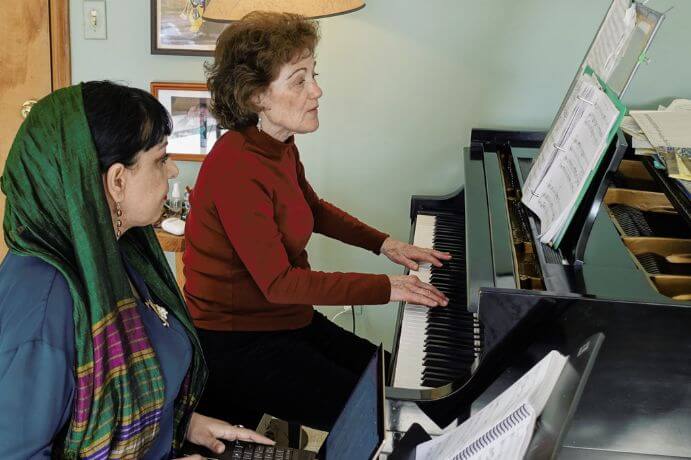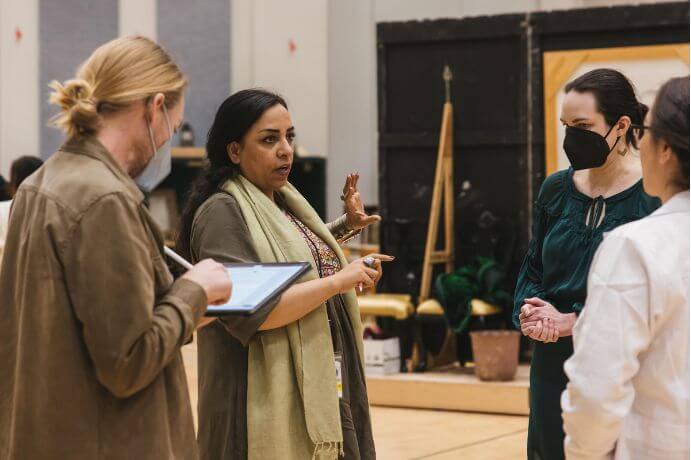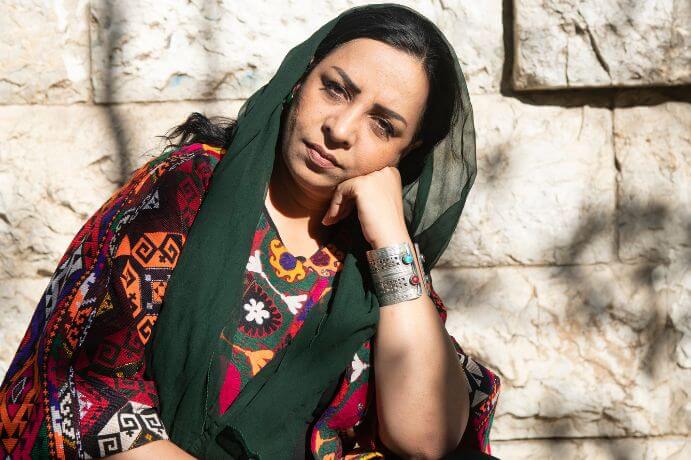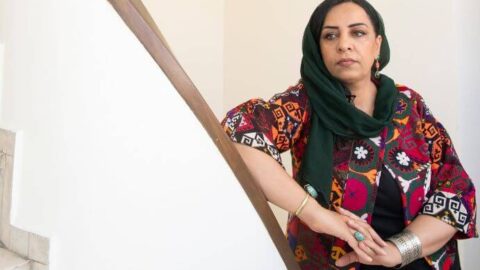Credited as one of the first women to direct film in post-(2001) Taliban Afghanistan, Roya Sadat centers feminism, truth-telling, and the stories of Afghan women and girls in the face of repression. Sadat grew up in the culturally dense city of Herat, where she studied politics, while also finding time to create and direct films and plays. When the Taliban regime came to power in 1996, they harshly restricted the rights of women and girls to work, be educated, or largely participate in society. Sadat emerged an internationally renowned artist and visionary after the Taliban’s forced removal in 2001 with bold and risky films (like A Letter to the President, which depicts a wife returning a slap to her abusive husband), and the creation of organizations that champion the work of women artists across the globe.
From Feb. 25 through March 11, Seattle Opera will present the premiere of A Thousand Splendid Suns, a new opera directed by Sadat that features the music of Sheila Silver and follows the novel of the same name by Afghan-American novelist Khaled Hosseini (most widely known for The Kite Runner). The piece offers a window into daily life under Taliban rule, as Sadat aids in giving a voice to those who struggle to be heard.
Work on A Thousand Splendid Suns began in 2009, before the Taliban returned to power in 2021. How has the opera’s direction changed since the beginning until now, when it seems that contemporary political movements have shifted to the right globally?
I was actually at Seattle Opera for our first production meeting when I read the shocking news of the Taliban’s arrival in my home city of Herat on August 15, 2021. I was in shock. I saw my city again in black and ruin. It felt like the roof was collapsing on my head. That event changed my entire outlook on this opera. The story has always been personal for me — it takes place in my home city, but it also depicts a reality that I have lived. It used to depict something that had happened in the past. It used to remind me of femininity and historical heroism. But now it is a reflection of millions of women who are facing the same fate today. The events of the story are happening once again in my country. The genocide of the Hazaras is happening in my country. And the struggles that Mariam and Laila endure are happening again for the women of Afghanistan, who are being deprived of the right to work, the right to an education — the most basic of human rights.
It is vital that we not forget the humiliation and suffering that women endure through warfare, from past conflicts through to the present day. We are seeing these effects all around the world: Syrian women, Ukrainian women, Iranian women, the women captured by the Taliban. Women all over the world are suffering due to political injustice. The opera stage has given me the strength to be the voice for those millions of women whose right to speak has been taken away.

What was it like collaborating with composer Sheila Silver and librettist Stephen Kitsakos, and how did you balance all your ideas while still staying authentic to the overall narrative?
My experience working with Sheila and Stephen has been wonderful. Sheila takes great pride in her work and has been very invested in its development. When I first came onboard the project, Sheila came out to Virginia to meet me at the first opportunity. We worked together for two straight days, talking through the opera and our shared vision for the story. Sheila played the piano with energy and feeling, which brought the music of the opera to life for me. I have since been out to visit Sheila at her beautiful home in the Hudson Valley, but that first visit set the tone for our relationship. We have become good friends and colleagues.
Much of the hard work of our design plan occurred during the height of the pandemic, so we had many meetings over Zoom with Sheila, Stephen, and the rest of the design team. I remember hearing Stephen read the libretto with Sheila for the first time on Zoom — I was swept up in the feeling of their reading. It was as though they were singing on the opera stage. I have leaned heavily on my colleagues to help me learn more about how opera works. Sheila and Stephen have helped me by playing and singing through the opera together with me many times. With their help, the coordination between music and words has become less challenging, and I’m quite proud of what we’ve been able to accomplish.
You began your directorial career by producing films. What then drew you to opera, and how does your process differ when it comes to creating for each medium?
The musical atmosphere of opera, the types of storytelling it is capable of, and its arrangements of scenes are all attractive to me. Opera has a unique and fascinating style that is certainly different from film. But the language of both opera and film is the language of art, the language of feeling. They both convey goodness, beauty, and creativity. This is the most important feature that opera and film have in common.
In my opinion, the most important aspect of any art form is creativity, regardless of method or technique. And in order to create, one must first understand life. So although opera and film are very different genres, their spiritual dimensions are very similar. I have really enjoyed taking on the challenge of finding the soul that animates opera, and I’ve found myself getting immersed in the work just like I do when directing film.

Working on this opera has been a tremendous experience full of exciting new creative opportunities. As I have learned more about opera as an art form, I have found that it offers a degree of flexibility even greater than cinema, and I’m finding that I can recreate my mental images more easily on the opera stage than on film. I feel that I’m becoming more and more interested in opera!
You’ve also established Roya Film House and the International Women’s Film Festival. Can you talk about your involvement with these projects and how they tie into your focus on empathy and human rights advocacy?
My films have always focused on women’s rights and perspectives. My first film, Three Dots, premiered in 2003, just two years after September 11. Amid all the bigotry and warfare and religious fundamentalism, my film — with a female theme and shot through a female lens — was screened for the first time, in the same old theater in Herat where I was first inspired to create art. That film was eventually shown in domestic and international festivals and received many awards. It introduced me as the first female filmmaker in Afghanistan.
Then, in 2004, my sister Alka Sadat and I founded the first women’s film production company, Roya Film House. My husband joined in 2009, and we founded the Herat International Women’s Film Festival in 2013. It was the first international festival in the region and the only platform through which people could access cinema focused on women’s issues around the world. We are working to keep this festival alive in U.S., because I think it is an especially important time to uplift these perspectives.
For 22 years I have studied romance and made films. I live in the world of images. There is a hair’s breadth between my personal life and my work life. We still continue our work despite many challenges. And I am still full of hope that one day I will return to my home country to shoot a film in the streets of my city and my country once again.
Like all directors, I want my work to bring people together under one roof and encourage them to think empathetically about the needs of other people. We still live in an unfair world. Equality and freedom belong to all people in the world, like the sun, wind, and rain…
The work you do is commendable — and vital — in terms of illuminating human/women’s rights issues despite an oppressive regime’s desire to control the narrative, along with preserving and presenting collective history/memory. What are some ways that the Western contemporary arts spheres can be in mindful and intentional solidarity with the movements you uplift through your work?
I think there is sometimes a broader misunderstanding of Afghan culture in the West. My country is unknown to the people of the United States, despite the connection between our countries. Our nations know each other only through the news, through politics — we are not connected through our art and culture. Art has always empowered me, and politics has always disappointed me. Art is for empathy and politics is for power. They are two separate roads that never meet.

I think there’s also a tendency to see the Taliban as representative of Afghan culture, to see their cruelty as Afghan cruelty. But it is not. The Taliban is an extremist group, they are a terrorist group. They are not the same as the 50 million people who call Afghanistan their home. And the power they have exerted over life in Afghanistan has not always been the way of life there. I want my work to change that. I hope A Thousand Splendid Suns will demonstrate the humanity of our people and show a different side of Afghanistan from American audiences are used to seeing.
Afghanistan has a strong, brilliant culture full of art, literature, music, poetry, and architecture, as well as a rich tradition of love stories. Society can be saved with knowledge and art. Let us unite for a world without terror.
I CARE IF YOU LISTEN is an editorially-independent program of the American Composers Forum, and is made possible thanks to generous donor and institutional support. Opinions expressed are solely those of the author and may not represent the views of ICIYL or ACF.
You can support the work of ICIYL with a tax-deductible gift to ACF. For more on ACF, visit the “At ACF” section or composersforum.org.
























